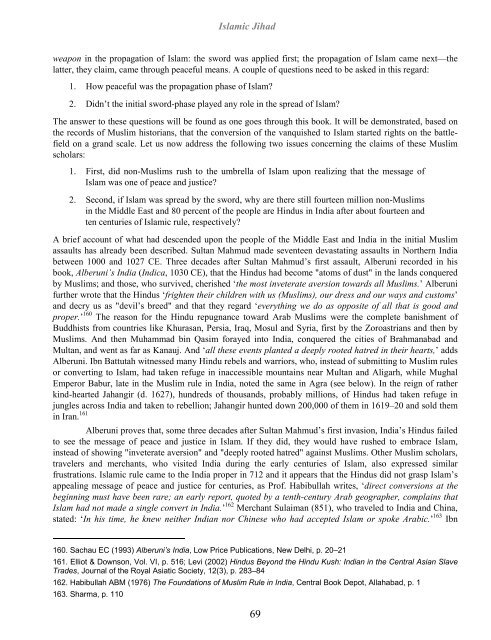islamic-jihad-legacy-of-forced-conversion-imperialism-slavery
islamic-jihad-legacy-of-forced-conversion-imperialism-slavery
islamic-jihad-legacy-of-forced-conversion-imperialism-slavery
- No tags were found...
You also want an ePaper? Increase the reach of your titles
YUMPU automatically turns print PDFs into web optimized ePapers that Google loves.
Islamic Jihadweapon in the propagation <strong>of</strong> Islam: the sword was applied first; the propagation <strong>of</strong> Islam came next—thelatter, they claim, came through peaceful means. A couple <strong>of</strong> questions need to be asked in this regard:1. How peaceful was the propagation phase <strong>of</strong> Islam?2. Didn’t the initial sword-phase played any role in the spread <strong>of</strong> Islam?The answer to these questions will be found as one goes through this book. It will be demonstrated, based onthe records <strong>of</strong> Muslim historians, that the <strong>conversion</strong> <strong>of</strong> the vanquished to Islam started rights on the battlefieldon a grand scale. Let us now address the following two issues concerning the claims <strong>of</strong> these Muslimscholars:1. First, did non-Muslims rush to the umbrella <strong>of</strong> Islam upon realizing that the message <strong>of</strong>Islam was one <strong>of</strong> peace and justice?2. Second, if Islam was spread by the sword, why are there still fourteen million non-Muslimsin the Middle East and 80 percent <strong>of</strong> the people are Hindus in India after about fourteen andten centuries <strong>of</strong> Islamic rule, respectively?A brief account <strong>of</strong> what had descended upon the people <strong>of</strong> the Middle East and India in the initial Muslimassaults has already been described. Sultan Mahmud made seventeen devastating assaults in Northern Indiabetween 1000 and 1027 CE. Three decades after Sultan Mahmud’s first assault, Alberuni recorded in hisbook, Alberuni’s India (Indica, 1030 CE), that the Hindus had become "atoms <strong>of</strong> dust" in the lands conqueredby Muslims; and those, who survived, cherished ‘the most inveterate aversion towards all Muslims.’ Alberunifurther wrote that the Hindus ‘frighten their children with us (Muslims), our dress and our ways and customs’and decry us as "devil’s breed" and that they regard ‘everything we do as opposite <strong>of</strong> all that is good andproper.’ 160 The reason for the Hindu repugnance toward Arab Muslims were the complete banishment <strong>of</strong>Buddhists from countries like Khurasan, Persia, Iraq, Mosul and Syria, first by the Zoroastrians and then byMuslims. And then Muhammad bin Qasim forayed into India, conquered the cities <strong>of</strong> Brahmanabad andMultan, and went as far as Kanauj. And ‘all these events planted a deeply rooted hatred in their hearts,’ addsAlberuni. Ibn Battutah witnessed many Hindu rebels and warriors, who, instead <strong>of</strong> submitting to Muslim rulesor converting to Islam, had taken refuge in inaccessible mountains near Multan and Aligarh, while MughalEmperor Babur, late in the Muslim rule in India, noted the same in Agra (see below). In the reign <strong>of</strong> ratherkind-hearted Jahangir (d. 1627), hundreds <strong>of</strong> thousands, probably millions, <strong>of</strong> Hindus had taken refuge injungles across India and taken to rebellion; Jahangir hunted down 200,000 <strong>of</strong> them in 1619–20 and sold themin Iran. 161 Alberuni proves that, some three decades after Sultan Mahmud’s first invasion, India’s Hindus failedto see the message <strong>of</strong> peace and justice in Islam. If they did, they would have rushed to embrace Islam,instead <strong>of</strong> showing "inveterate aversion" and "deeply rooted hatred" against Muslims. Other Muslim scholars,travelers and merchants, who visited India during the early centuries <strong>of</strong> Islam, also expressed similarfrustrations. Islamic rule came to the India proper in 712 and it appears that the Hindus did not grasp Islam’sappealing message <strong>of</strong> peace and justice for centuries, as Pr<strong>of</strong>. Habibullah writes, ‘direct <strong>conversion</strong>s at thebeginning must have been rare; an early report, quoted by a tenth-century Arab geographer, complains thatIslam had not made a single convert in India.’ 162 Merchant Sulaiman (851), who traveled to India and China,stated: ‘In his time, he knew neither Indian nor Chinese who had accepted Islam or spoke Arabic.’ 163 Ibn160. Sachau EC (1993) Alberuni’s India, Low Price Publications, New Delhi, p. 20–21161. Elliot & Downson, Vol. VI, p. 516; Levi (2002) Hindus Beyond the Hindu Kush: Indian in the Central Asian SlaveTrades, Journal <strong>of</strong> the Royal Asiatic Society, 12(3), p. 283–84162. Habibullah ABM (1976) The Foundations <strong>of</strong> Muslim Rule in India, Central Book Depot, Allahabad, p. 1163. Sharma, p. 11069


